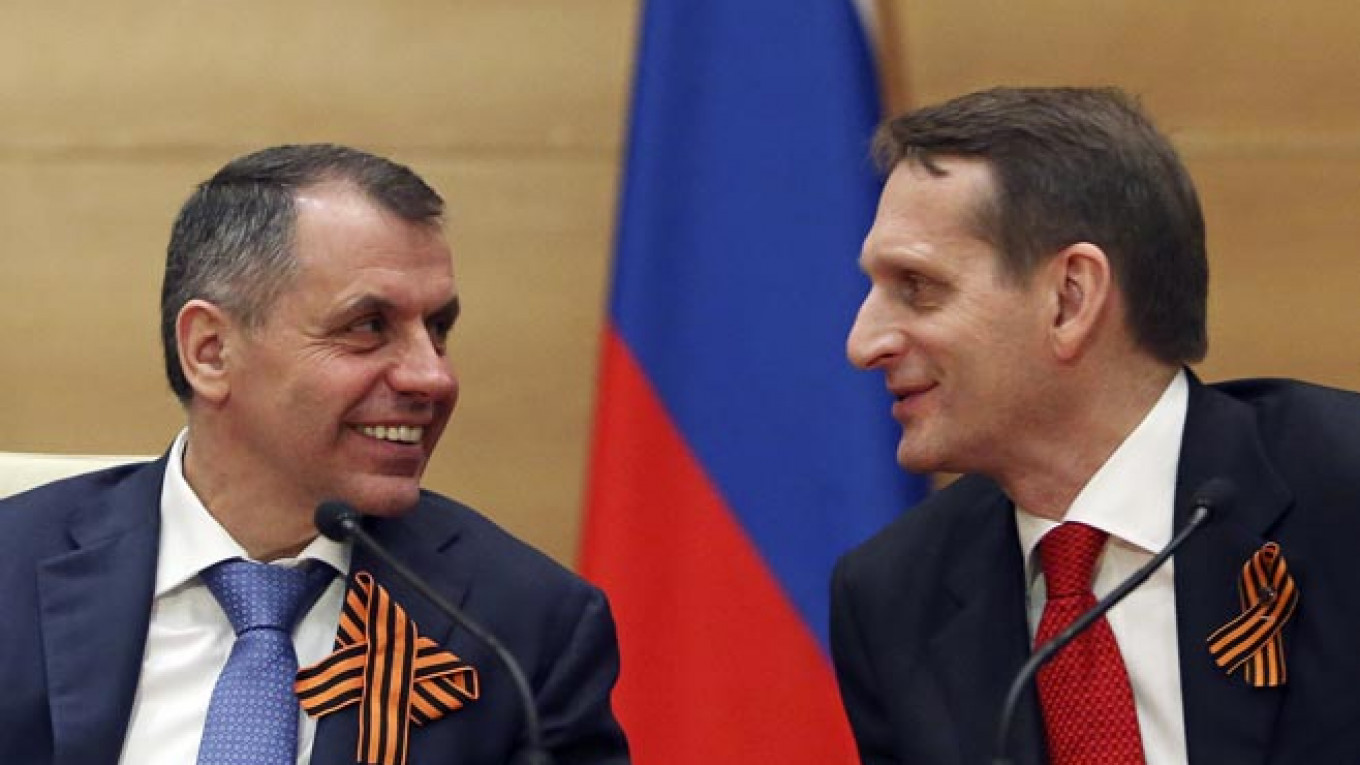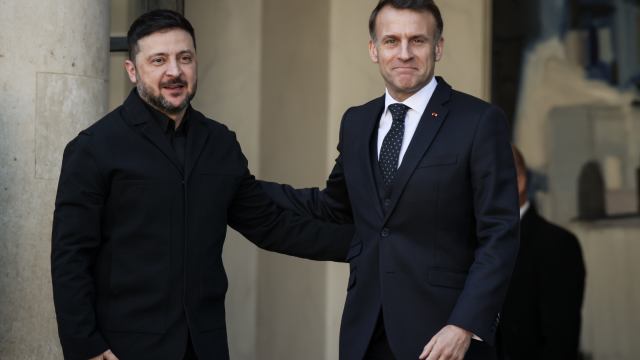For those accustomed to the unvarying dark suits of State Duma deputies, the streak of orange that adorned their lapels at a plenary session last week might have looked unusual.
Amid a government drive to rally support behind Russia's move to annex Crimea, this piece of cloth with orange and black stripes known as a St. George ribbon has become an almost obligatory accessory for politicians and pro-Kremlin patriots.
Along with the Russian tricolor, which Moscow City Hall has encouraged residents to hang from their balconies to show their approval of the Crimea takeover, the St. George ribbon, also known as the Georgian ribbon, has seen a major revival as the authorities seek out symbols to unite the country behind its controversial actions in Ukraine.
The ribbons have been worn for years to commemorate the Soviet Union's defeat of Nazi Germany in World War II. Now they have been adopted by Russians who oppose the Western-backed regime in Kiev, which the Kremlin says is led by Nazi sympathizers and "fascists." Members of the Berkut, the special units of Ukraine's police notorious for their brutality, also wore the ribbons before being disbanded by the new Ukrainian government.
"The ribbon is a symbol of victory," said Konstantin Kudryashov, deputy general director of Promo Lenta, a textile manufacturer in the Moscow region that produces 4 million to 5 million Georgian ribbons a year. "Many people died for our victory in World War II. The ribbons are probably being worn more often these days because people are happy that Crimea is a part of Russia again."
But activists from Russia's political opposition who criticize the Kremlin's actions in Crimea have mocked the sudden growth in the ribbon's popularity. Opposition leader Alexei Navalny derided lawmakers in a recent blog post as "fat-faced deputies with St. George bows on their Zegna jackets and 450,000-ruble salaries," saying they cared little about the problems of ordinary Russians.
This hostility toward the spread of the ribbons is shared, in part, by one group without a political stake in the Ukraine crisis: specialists in heraldry.
"The proliferation of Georgian ribbons is tied to certain realities in contemporary Russian history," said Mikhail Medvedev, an associate member of the International Academy of Heraldry who specializes in Russian heraldic practice, by telephone. "Now the ribbon is being used to mobilize the masses. Whether one wears it depends more on the current social mood than on personal choices."
Recent polls show that the vast majority of Russians agree with the state's narrative about nationalists and "fascists" being a dangerous threat in Ukraine, and with Russia's annexation of Crimea.
A Complex History
The ribbons dot the landscape of former Soviet republics year-round, but they are most visible in Russia when the country celebrates Victory Day on May 9. The ribbons are tied to car antennas, pinned to backpacks, attached to clothing or dangle from rear-view mirrors. They are sometimes even used to adorn vodka bottles and dog collars.
The origin of the ribbons can be traced back to 1769, when Catherine the Great instituted the Order of St. George as the highest military decoration of Imperial Russia. The order consisted of a ribbon with five stripes, three black and two orange, attached to a St. George cross.
Italian Count de Litta, who served in the Russian navy during the Russo-Turkish war of 1787 to 1792, wrote in 1833 that the ribbon's black stripes represented gunpowder while the orange ones stood for fire. Other interpretations have suggested that the colors were inspired by the Russian coat of arms: a black double-headed eagle on a gold background.
Recent findings by Medvedev, of the International Academy of Heraldry, show that its colors could have come from the coat of arms of Catherine the Great's native region in modern-day Germany.
The St. George ribbon is also one of the few symbols that was used in both Imperial Russia and the Soviet Union. It reappeared in 1943 as part of the Order of Glory, a military decoration awarded to privates, sergeants and aviation second-lieutenants of the Red Army who "displayed glorious feats of bravery, courage and fearlessness in the battle for the Soviet Motherland" in World War II.
The award was discontinued when the Soviet Union collapsed, but the cross of St. George was reintroduced as a Russian state award in 1992.
In today's Russia, instead of being a symbol of special recognition, the St. George ribbon has become an adornment for everyone to wear around Victory Day and a general emblem of patriotism and support for the Kremlin. In 2005, journalists from RIA Novosti and a social organization known as Student Community inaugurated the "Georgian Ribbon" campaign, an annual initiative that calls for volunteers to distribute ribbons in the streets of Russia ahead of Victory Day.
According to organizers of the campaign, its objective is to provide people with a token to recognize the loss of millions of lives in the Soviet Union during World War II and to show pride in Russia's feats of the past. The campaign also encourages the companies that produce St. George ribbons to donate a portion of their profits to military hospitals or charities that support veterans and military families.
Last year, volunteers distributed more than 3 million ribbons in the streets of Moscow, while campaign organizers supplied St. George ribbons to Russian embassies in 73 countries.
"The level of patriotism in Russia is quite low right now," said Kudryashov, of Promo Lenta. "The people who wear the ribbon show that they have not forgotten the war, and that is a positive thing. I see it an an embodiment of Russian unity."
But for Medvedev, the democratization of the ribbon not only reflects the current political mood but also demonstrates a misunderstanding of the country's rich history of military distinctions.
"In Imperial Russia and Soviet times, the St. George ribbon was associated with military prowess," Medvedev said. "The award, which was accompanied by the ribbon, had to be deserved. But in the post-Soviet era, we are faced with a mass misunderstanding of Russia's culture of awards. The use of the Georgian ribbon as a souvenir is exclusive to the post-Soviet era."
The decoration saw a major revival two years ago following an eruption of an opposition protest movement, whose adherents adopted a white ribbon as their symbol. Pro-Kremlin activists responded by adorning the orange-and-black striped St. George ribbon.
Some citizen organizations view the ubiquitousness of Georgian ribbons as a tawdry fashion trend. Anti-Kremlin activists have come to dub the symbol the "Colorado ribbon" because its colors evoke the pattern on the backs of Colorado potato beetles.
"People often do not understand the ribbon they are putting on, why they are putting it on and the implications of where they are wearing it," said Vasily Makogon, a computer programmer who founded a website that advocates for a more conservative use of the ribbon. "Although I feel like the situation has improved in the last few years, the ribbon is still kitschy and worn as an accessory, as a fashionable little thing."
When asked about the common practice of placing a St. George ribbon on one's car, Medvedev said he disapproved.
"I would compare attaching a Georgian ribbon to a car to using inappropriate language in a literary context," Medvedev said. "It can come off as vulgar. But unfortunately that is not something unusual in today's politics."
Contact the author at [email protected]
A Message from The Moscow Times:
Dear readers,
We are facing unprecedented challenges. Russia's Prosecutor General's Office has designated The Moscow Times as an "undesirable" organization, criminalizing our work and putting our staff at risk of prosecution. This follows our earlier unjust labeling as a "foreign agent."
These actions are direct attempts to silence independent journalism in Russia. The authorities claim our work "discredits the decisions of the Russian leadership." We see things differently: we strive to provide accurate, unbiased reporting on Russia.
We, the journalists of The Moscow Times, refuse to be silenced. But to continue our work, we need your help.
Your support, no matter how small, makes a world of difference. If you can, please support us monthly starting from just $2. It's quick to set up, and every contribution makes a significant impact.
By supporting The Moscow Times, you're defending open, independent journalism in the face of repression. Thank you for standing with us.
Remind me later.






